The Kingdom of Glitter by Shanzay Subzwari
MFA Thesis Final Submission at School of Art, Architecture and Design, London Metropolitan University, 2020, U.K.
Awarded a Distinction.
WATCH VIDEO BELOW
Layers of papercuts, animation, sound effects, special effects, news, audio and text come together to form a complex narrative; sometimes flowing into each other, sometimes jarring. Fantastical, whimsical imagery merges with pandemics and natural disasters. The Dystopian Fairytale of the 21st Century emerges, with the The Evil Monsters (Covid-19, Devastating Monsoon) in a tussle with the Superheroes (Medical Staff, Karachi's citizens). Kitsch appears in the form of snowy and rainy effects, saturated waterfall wallpapers, dazzling starry skies, and Disney and pop-culture elements.
Covid-19 has played a big role in shaping the imagery of my work, with silhouettes of medical workers, flags bearing messages of hope and fear, and newly-essential utilities such as liquid soaps and hand sanitisers making an appearance. While pursuing my MFA in London when I had to rush back to Pakistan for 4 months in March 2020 owing to the Covid-19 pandemic, the unreal feeling of the world around me collapsing left a strong residue.



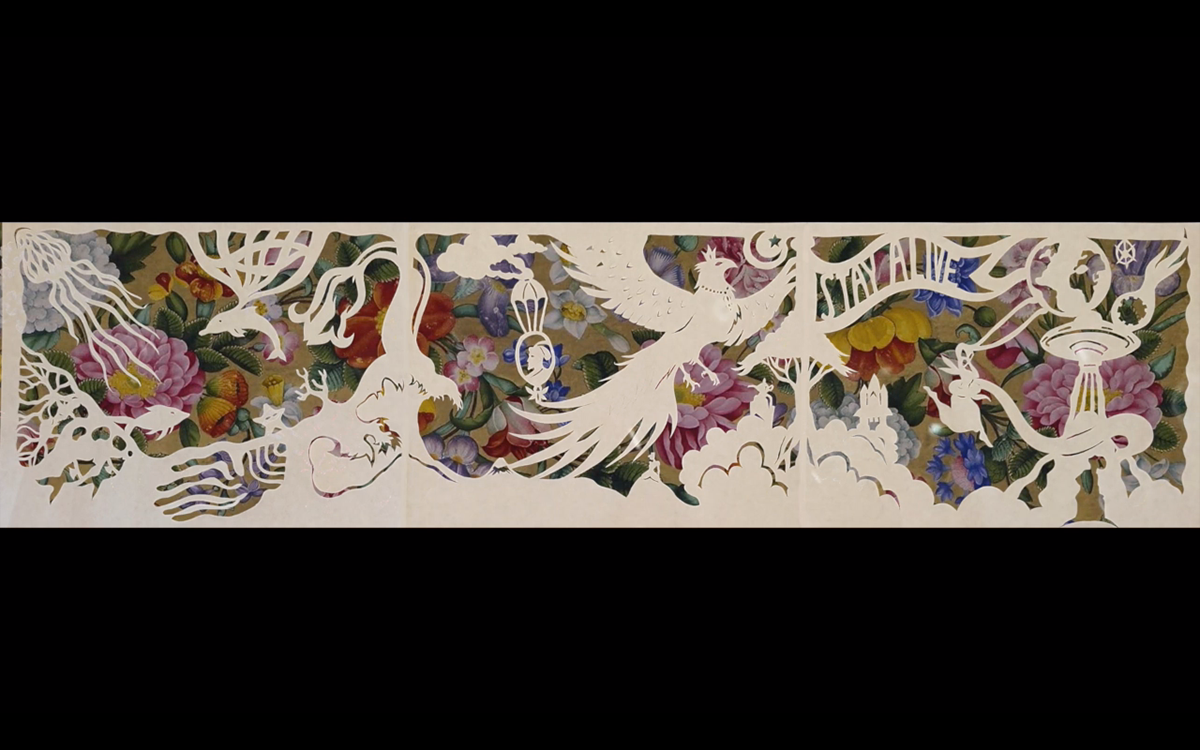
With training in Mughal Miniature painting- a technique that has been around in South Asia since the Mughal period in the 16th Century- it is imperative that my work contains elements from my culture. As with many things in life, there has been a clashing and colliding of cultures in my London experience which has inadvertently been reflected in my work: a traditional Pakistani motif here and there, a crowned Mughal Emperor lost between extensive tree-like imagery, an Emperor merged with a bird, or an incredibly detailed floral Mughal Miniature border as the backdrop of a papercut. One will occasionally hear desi, traditional South Asian music (tabla and flute) emerging between quintessentially ‘Western’ music and contravening in parts.
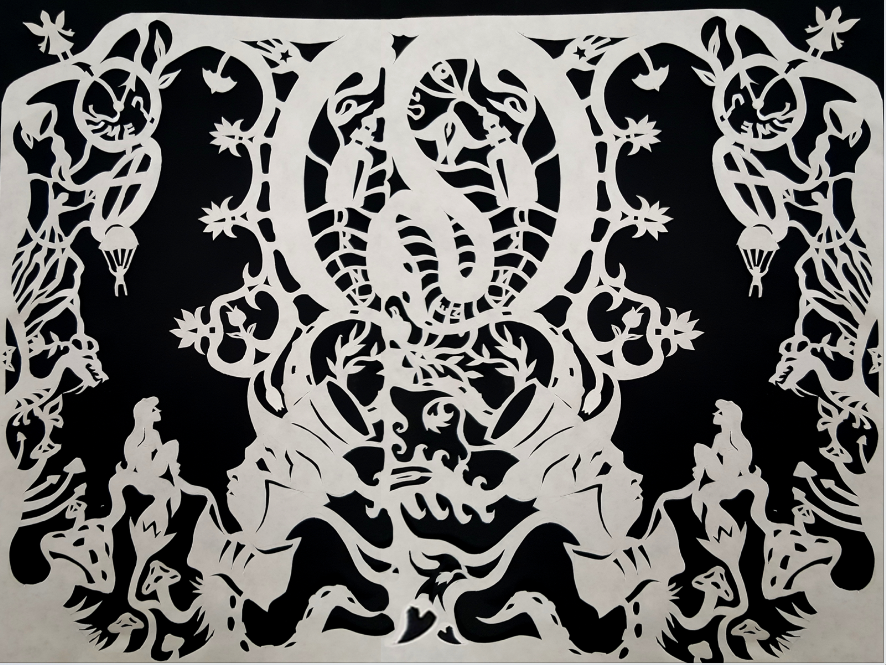



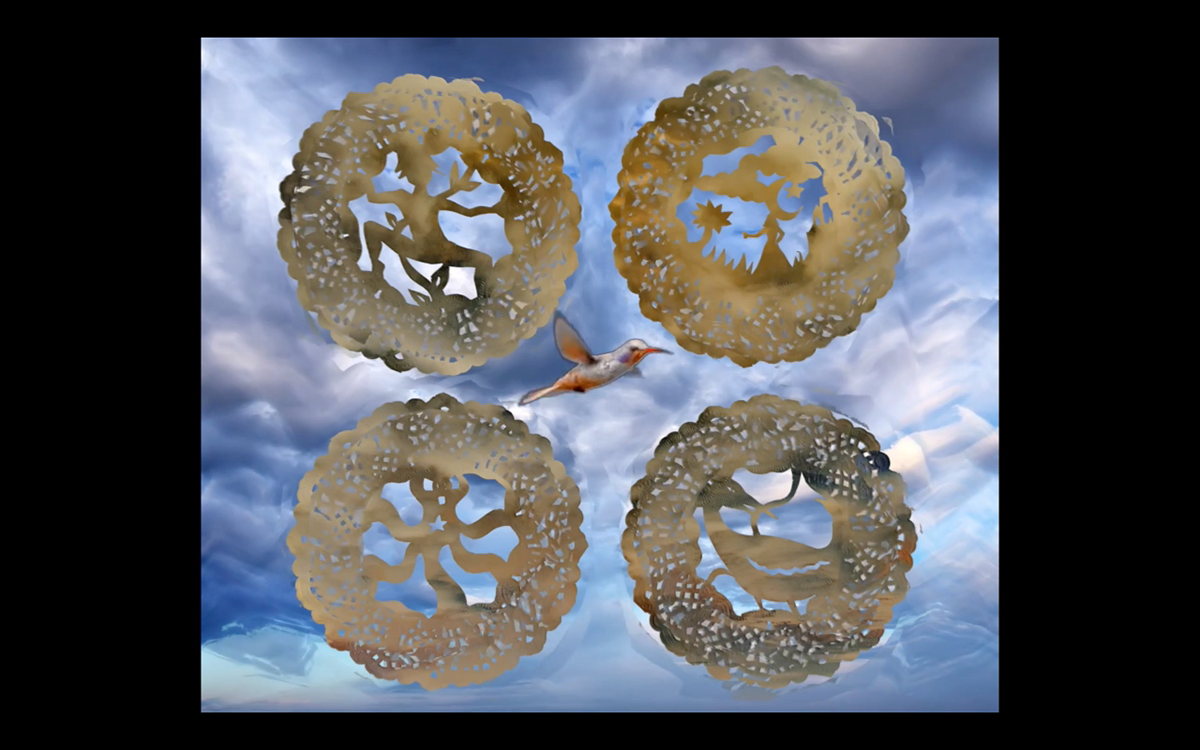
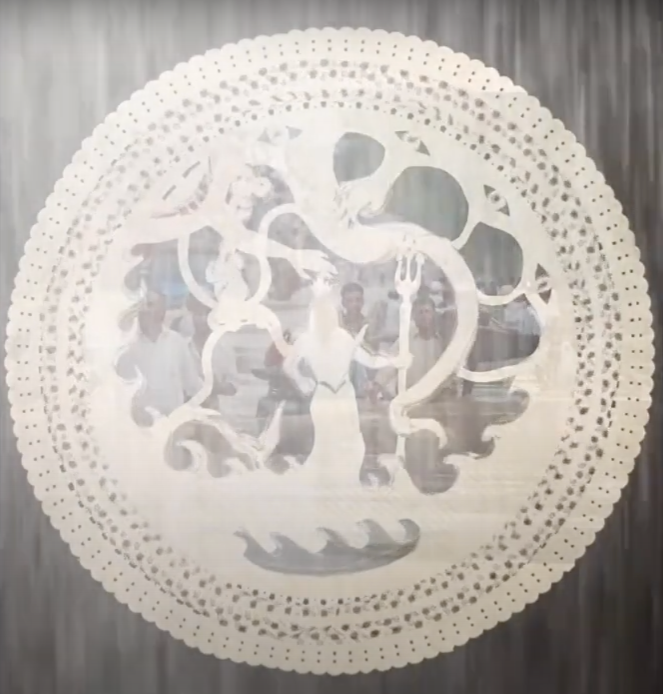
I have also explored my changed relationship with rain. With the extremely heavy Monsoon season in 2020 bringing in unexpected floods and destruction in my city, Karachi, (a city by the sea where it hardly rains and where rain is usually welcomed), I have evolved from being a rain-lover to a skeptic. My cinemagraph of Poseidon overlaid upon half-drenched Pakistani Monsoon affectees, with popular-culture imagery and the sound of heavy rain superimposed upon them, is my testament to the helplessness and sorrow I felt regarding the situation in Karachi where people lost their homes due to floodwater.
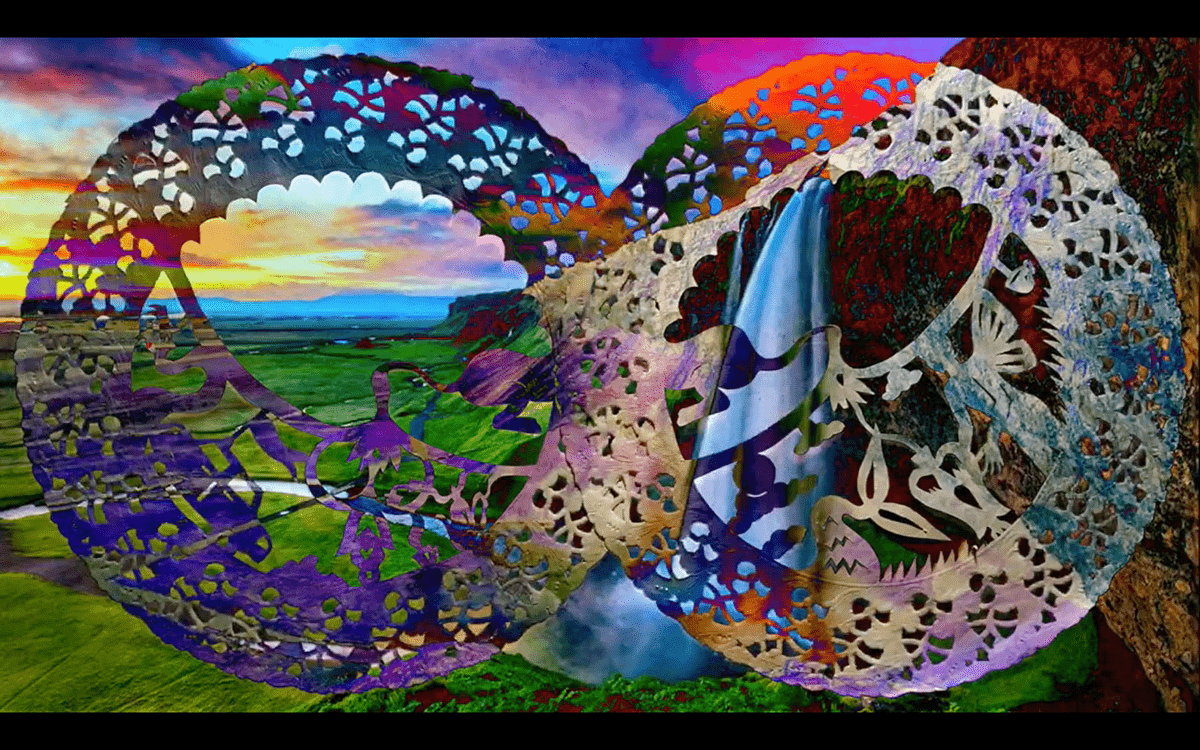

Paper-cutting is a skill I began exploring in 2020 when I bought an Xacto-knife upon a whim. The drawing and cutting of silhouettes on paper was something completely new to me, but a technique that I got a grasp of easily. I created ‘moving imagery’ with my papercut pieces in the form of cinemagraphs with the aid of digital programs and applications. There are touches of glamour and a lot of theatricality. When the curtains metaphorically ‘draw to a close’ as ill-timed applause drowns a distressed doctor’s Covid-19–related experiences, the ‘Kingdom of Glitter’ that we all live in, falls to the floor.
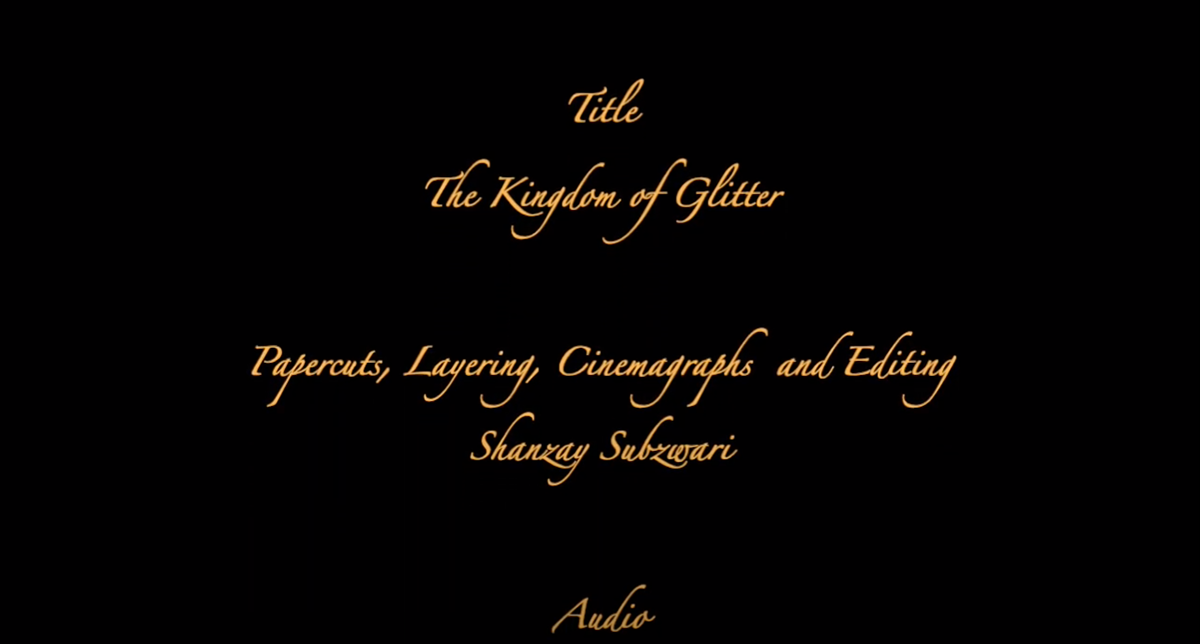
PAPERCUT CINEMAGRAPHS
The images you see in A Kingdom of Glitter are papercut cinemagraphs.
What is a cinemagraph?
Often described as Harry Potter-like moving images, cinemagraphs are still photographs in which a minor and repeated movement occurs, forming a video clip. They can be published as an animated GIF or in other video formats, and can give the illusion that the viewer is watching an animation in a never-ending loop.
What was the process of creating the video piece?
For my video piece, I hand-cut paper to create between 18-20 papercut illustrations on paper and paper doilies in a variety of sizes and compositions, and shortlisted 13 of those. These were then photographed and enhanced on Adobe Photoshop by creating a variety of overlays with stock photographs of kitsch, natural phenomena and world events. These ‘enhanced’ papercuts then underwent a process of motion-creation, with masking, unmasking and animation tools in play to create movement in certain areas and by adding overlays of objects if required. These ‘moving’ papercuts therefore became papercut cinemagraphs.
The final stage was putting it all together in a video editing software; steps involved included arranging the cinemagraphs in a sequence with video effects, sound effects and audio clips, as well as opening and closing credits. Various decisions were taken and things added and removed, particularly regarding the duration of each papercut cinemagraph, their transitions, fonts, sound and audio placements.
What makes these particular cinemagraphs unusual?
I have seen cinemagraphs made from photographs, but in my brief knowledge and research, a papercut cinemagraph is unusual. The Kingdom of Glitter not only consists of hand-cut paper, but hand-cut paper doilies as well, which bring a new meaning and context to the works, particularly because of my Pakistani heritage. I greatly enjoyed the challenging multi-layered creation process.
Stages of Creation
Below I have outlined the stages of creation of the video cinemagraph piece:
Step 1: Making the papercut by drawing imagery with pencil and cutting out negative spaces with an Xacto-knife
Step 2: Photographing the finished papercut against a dark surface
Step 3: Making variations on Adobe Photoshop by trying out different photographic overlays
Step 4: Choosing the final papercut overlay and turning it into a cinemagraph by masking certain areas and ‘animating’ others to create movement, and adding further overlays and filters (if required)
Step 5: Finally, when all the papercut cinemagraphs were ready, putting them together to make a cohesive 6 min 32s video-art piece with layers, transitions, credits and audio
While the above cinemagraphs could have worked as individual pieces (as was my initial intention), I felt they were working much better as a cohesive, comprehensive piece. This is because as a continuous narrative I was able to explore how all my concerns and themes are interrelated, and no particular theme exists in isolation.
THEMES AND INFLUENCES
I believe my video The Kingdom of Glitter stems from my recent foray into kitsch, particularly after reading Celeste Olalquiaga’s book The Artificial Kingdom, which is known as a ‘treasury of the kitsch experience’. This interest transfused with my earlier practice of exploring socio-political ideas and popular culture in my paintings. Other factors that have inadvertently influenced the imagery and ideas in this video piece are my Pakistani heritage, and my foray as an MFA student into ‘foreign’ British culture which did not feel alien when I called it home for a year.
So, what happens in this piece? Layers of papercuts, animation, sound effects, special effects, news, audio and text come together to form a complex narrative; sometimes flowing into each other, sometimes jarring. Fantastical, whimsical imagery merges with pandemics and natural disasters. The Dystopian Fairytale of the 21st Century emerges, with the The Evil Monsters (Covid-19, Devastating Monsoon) in a tussle with the Superheroes (Medical Staff, Karachi's citizens). Kitsch appears in the form of snowy and rainy effects, saturated waterfall wallpapers, dazzling starry skies, and Disney and pop-culture elements. Whether these elements appear jarring or subtle, overbearing or interestingly complex, depends on each viewer’s interest and perception.
Covid-19 has played a big role in shaping the imagery of my work, with silhouettes of medical workers, flags bearing messages of hope and fear, and newly-essential utilities such as liquid soaps and hand sanitisers making an appearance. When I had to rush back to Pakistan for 4 months in March owing to the Covid-19 pandemic, the unreal feeling of the world around me collapsing left a strong residue. I could not help but capture it in my work.
An interesting area I have explored within my imagery has been my changed relationship with rain. With the extremely heavy Monsoon season bringing in unexpected floods and destruction in my city, Karachi, (a city by the sea where it hardly rains and where rain is usually welcomed), I have evolved from being a rain-lover to a skeptic after moving to London. My cinemagraph of Poseidon overlaid upon half-drenched Pakistani Monsoon affectees, with popular-culture imagery and the sound of heavy rain superimposed upon them, is my testament to the helplessness and sorrow I feel regarding the current situation in Karachi where people have lost their homes due to floodwater. It is in the last week that two of my friends and I began an urgent world-wide art initiative to raise funds for this cause, called ‘Artists for Flood Relief’ [4].
Being a Pakistani with training in Mughal Miniature painting, a technique that has been around in South Asia since the Mughal period in the 16th Century, it is imperative that my work contains elements from my culture. As with many things in life, there has been a clashing and colliding of cultures in my London experience which has inadverdently been reflected in my work: a traditional Pakistani motif here and there, a crowned Mughal Emperor lost between extensive tree-like imagery, an Emperor merged with a bird, or an incredibly detailed floral Mughal Miniature border as the backdrop of a papercut. One will occasionally hear desi, traditional South Asian music (tabla and flute) emerging between quintessentially ‘Western’ music and contravening in parts.
As far as paper-cutting is concerned, it is a skill I only began exploring in late February this year when I bought an Xacto-knife upon a whim. Having a strong background in different kinds of painting for many years, the drawing and cutting of silhouettes on paper was something completely new to me, but a technique that I got a grasp of easily. With influences such as Kara Walker in mind with her politically eye-opening silhouettes, and by exploring videos by Pippilotti Rist and the Chapman Brothers’ (the latter’s renditions of Hell), I got a sense of the power of theatricality and complexity in imagery, video and performance. William Kentridge’s pencil-drawing animations also opened my eyes to spectacular technique and the beauty of animation. This is the first time I ever explored the idea of creating ‘moving imagery’ with my pieces in the form of cinemagraphs, and I extensively learned and used digital programs and applications to aid me in this process. Earlier, my tools would be incredibly traditional (for example squirrel tail hair brushes and seashells to paint with and mix colours in, for my Mughal Miniature paintings).
Recently, when I was editing my video, I came across Les Trois Inventeurs, a 1980 papercut animation film by Michel Ocelot which used paper-doilies to animate a beautiful story[5]. Though my ‘animation’ in The Kingdom of Glitter is vastly different, the idea of the paper-doily is very interesting for me in the way it represents contrasting ideas in the UK and Pakistan (as I newly learned from some English friends). My decision to use a doily as a paper-cutting surface stemmed from a lack of smooth paper conducive to paper-cutting when I rushed back to Pakistan for a few months during the pandemic. Little did I know that this symbol of ‘refinement’, ‘wealth’, and ‘class’ (often used in frivolous tea-parties in Pakistani society) would turn out to be a working-class essential in the UK.
According to Celeste Olalquiaga’s book The Artificial Kingdom, ‘Kitsch exudes the peculiar sadness of broken or even half-forgotten dreams’ (pg. 291)[6]. My video piece is largely about the human condition; there are the paradoxes of joy and sadness, clarity and absurdity, hope and fear, fantasy and reality. In the video, there are no ‘Chapters’ as seen in fairy-tales or storybooks; it is as life is, flowing and jolting, unexpected and predictable, clichéd and novel. It is about current affairs, the social and the political. Among other sound-effects, one will hear ominous walkie-talkie and helicopter sounds in the piece that reflect the world today with its complexities, tragedies and war, in the menacing year that is 2020.
There are touches of glamour and a lot of theatricality. When the curtains metaphorically ‘draw to a close’ as ill-timed applause drowns a distressed doctor’s Covid-19–related experiences, the ‘Kingdom of Glitter’ that we all live in, falls to the floor.


